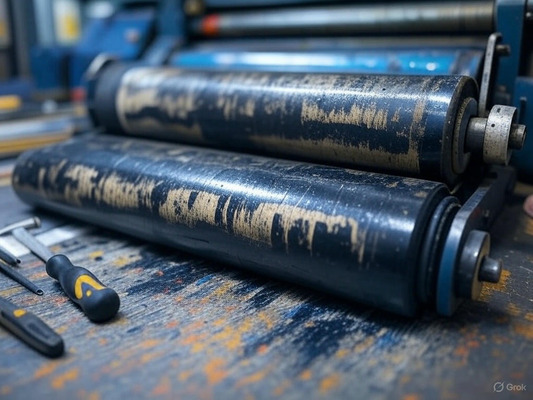Troubleshooting Guide For Printing Rollers

Printing rollers are essential for transferring ink evenly onto the printing surface. However, issues like uneven prints and wear can arise, affecting print quality and roller longevity. Below are common problems, their causes, and actionable solutions to resolve them.
Issue 1: Uneven Prints
Description: Uneven prints occur when ink is not applied uniformly, resulting in inconsistent or blotchy output.
Possible Causes
- Imperfections or damage on the roller surface (e.g., bumps, scratches, or depressions).
- Misalignment of the roller in the printing machine.
- Uneven pressure applied to the roller.
- Incorrect ink viscosity (too thick or too thin).
- Debris, dried ink, or residue on the roller.
Solutions
- Inspect the roller surface: Check for visible defects. If damage is found, resurface or replace the roller.
- Check alignment: Ensure the roller is properly aligned. Use alignment tools or adjust the mounting as needed.
- Adjust pressure settings: Calibrate the printing machine to apply uniform pressure across the roller.
- Verify ink consistency: Ensure the ink is of the correct viscosity. Thin or thicken the ink if necessary, or replace it.
- Clean the roller: Remove any debris or dried ink using appropriate cleaning agents. Clean regularly to prevent buildup.
Issue 2: Wear
Description: Wear refers to the gradual deterioration of the roller, which can lead to reduced performance and print quality over time.
Possible Causes
- Friction from constant contact with the printing surface or other components.
- Chemical exposure from inks or cleaning agents that degrade the roller material.
- Improper handling during installation or maintenance.
- Overuse beyond the roller’s recommended lifespan or capacity.
Solutions
- Use high-quality materials: Choose rollers made from durable materials like high-grade rubber or metal alloys for better wear resistance.
- Implement regular maintenance: Schedule routine cleaning, lubrication (if applicable), and inspections to detect early signs of wear.
- Ensure proper handling: Train staff on correct installation and handling techniques to avoid unnecessary damage.
- Monitor usage: Track the roller’s usage and replace it before it exceeds its recommended lifespan to avoid print quality issues.
- Use compatible chemicals: Select inks and cleaning agents that are suitable for the roller’s material to minimize chemical degradation.
Additional Common Issues
Issue 3: Slippage
Description: Slippage occurs when the roller fails to grip the printing surface properly, leading to misprints or incomplete ink transfer.
Possible Causes
- Worn or overly smooth roller surface.
- Incorrect tension settings on the printing machine.
Solutions
- Check roller surface condition: If the surface is too smooth or worn, resurface or replace the roller to improve grip.
- Adjust tension settings: Ensure the machine’s tension is set correctly. Increase tension if necessary to prevent slippage.
Issue 4: Ghosting
Description: Ghosting is when faint images or patterns from previous prints appear on new prints, often due to residual ink.
Possible Causes
- Inadequate cleaning, leaving residual ink on the roller.
- Use of incompatible cleaning agents that fail to remove all ink.
Solutions
- Thorough cleaning: Clean the roller meticulously between print runs to remove all ink residue.
- Use appropriate cleaning agents: Select solvents or cleaners specifically designed for the type of ink used.
Preventive Measures for Long-Term Performance
To minimize issues and extend the life of your printing rollers, consider these proactive steps:
- Establish a maintenance schedule: Regularly clean, inspect, and maintain rollers to catch issues early.
- Store rollers properly: When not in use, store rollers in a clean, dry environment to prevent damage or contamination.
- Train staff: Ensure that all operators are trained on proper handling, operation, and maintenance of printing rollers.
- Follow manufacturer guidelines: Adhere to the specific recommendations for your roller and printing machine to optimize performance.
Why This Matters for Customers
By addressing these common issues and following preventive measures, customers can:
- Improve print quality and consistency.
- Reduce downtime caused by roller-related problems.
- Extend the lifespan of their printing rollers, lowering replacement costs.
- Enhance overall efficiency and productivity in their printing operations.
This guide provides clear, actionable solutions to common printing roller issues, adding value by helping customers maintain high-quality prints and prolong the life of their equipment. For further assistance, consider offering resources like downloadable PDFs, video tutorials, or customer support hotlines.
View More News


.jpg)
